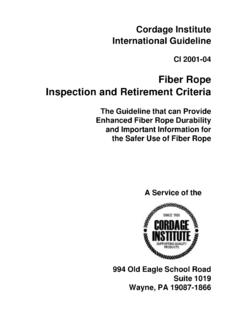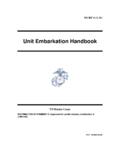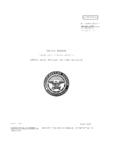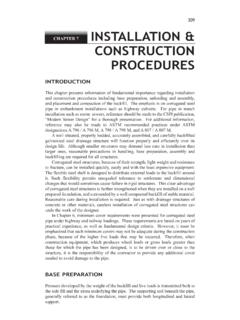Transcription of Central Texas Treatment Center - adultprobation.net
1 1 Central Texas Treatment Center Family Handbook October 2014 2 Table of Contents Way House GED Financial Visits, Admin Passes and Mail and Medical Prescription Phone Leaving Messages For Pending Legal Action and Daily Client Family Family Substance Abusing Family Incarcerated Family Family Members on Probation or Getting Help and Learning 3 Introduction In 1989, the Texas Legislature authorized the Central Texas Treatment Center as an alternative to incarceration. This gave the court system an alternative program to provide Treatment to persons on probation for substance abuse related offenses.
2 The Center opened its doors in November 1990 to provide both inpatient Treatment for substance abuse and criminal conduct, and a community-based correctional alternative to incarceration. This program has two equally important functions, Treatment and corrections. Though less restrictive than jail, the Center is considered to be a correctional facility, and residents must adhere to their Treatment plans, Center rules, and the conditions of their community supervision (probation). The Center serves residents of all ethnic groups, from many counties in Texas . In 2013, approximately 70% were Anglo, 20% were Hispanic, and 10% were African-American, and approximately 60% were from Williamson County.
3 Both men and women reside in the Center . Each gender is housed in a separate wing of the Center . The Center employs both male and fem ale staff of Anglo, Hispanic and African American dissent. Confidentiality Confidentiality is a major concern of Center staff. Information concerning the resident s being in the Center , their Treatment status, and progress in Treatment is considered privileged information and may be released only at the resident s request. Family members may, with the resident s knowledge and consent, schedule a one-on-one meeting with the resident s probation officer and/or counselor, or the resident may request that the probation officer or counselor call the family with information.
4 Persons calling the Center , requesting confidential information, will be asked for their name and phone number, and this information will be given to the probation officer or primary counselor to follow-up on. It would be very easy for someone to pose as a family member asking for confidential information. Please be patient with these precautions. Treatment Residents usually stay at the Center for between 180 days and 2 years (average length of stay is 245 days). A comprehensive Treatment plan is developed by the resident s Treatment team within 10 days of their arrival. Treatment may be extended depending on the resident s performance and progress in Treatment .
5 Treatment is divided into 4 phases: Challenge to Change (6 or more weeks); Commitment to Change (6 or more weeks); Ownership of Change (6 or more weeks); Aftercare (once weekly for 1 year following discharge from the Center ). Residents progress is evaluated regularly. Their progress depends on completion of cognitive curricula and adherence to Center rules. It costs the Center approximately $65 per day to provide Treatment . This includes three meals a day; clean, comfortable sleeping accommodations; essential personal hygiene items; educational programming; daily Treatment sessions; a safe, structured living environment; transportation to appointments; leisure/ recreational facilities; 12-step meetings; and opportunities to interact positively with the community and to complete required Community Service Restitution hours.
6 Center staff are competent, well trained and dedicated to serving the community. 4 Way House Requirement The majority of residents are required to live in a way house for the first three months following Treatment . way houses are resident managed houses where recovering addicts and alcoholics live together, providing support to each other to facilitate adjustment to a life in recovery. There are many such houses in Williamson and Travis Counties, and one in San Marcos and one in Waco. The resident chooses the house they will go to. The average monthly cost is about $350. The first months rent is required before move in.
7 This transitional living arrangement gives the newly graduated resident a chance to settle into the requirements of their new life in recovery before they return to the responsibilities of their regular lives. It is a very important part of our program and seldom is the requirement waived. GED Program Residents who enter the Center without a high school diploma or GED will be afforded the opportunity to get a GED. In 2011, 20 residents completed all sub-tests and qualified for the GED. Residents who earn a GED while at the Center attend the graduation ceremony and receive a graduation tassel. Those residents who need it will receive literacy tutoring and English as a Second Language assistance.
8 Financial Obligations A $215 medical/ program materials charge is levied on each resident entering Treatment . This covers the cost of 1 visit to the medical clinic or dentist, and program workbooks, handouts, phase bracelets, etc. Any money put into the resident s financial account will be used to pay off this materials charge until it is paid in full. Each resident is charged $3 per week for laundry. This covers the cost of hot water and repairs on the machines. Visits, Administrative Passes, and Off-Campus Activity Passes (OCAPs) Visitation and OCAPs are part of the Treatment process. Residents get to choose who they want to visit them in the Center .
9 Residents may sign up for visits after they pass the third step in their Moral Reconation class (Honesty). Visits are for one hour and take place in the Center s lobby either on Saturday or Sunday. The lobby accommodates 6 people at one time. It works best if only two people visit at one time, that way two residents can have visitors at the same time. No purses, packages, waist bags, diaper bags, cell phones, toys, weapons, food or drinks are allowed in the Center . Items must be mailed to the resident, not brought to them during visits. The Center phone number is (512) 943-1211. Please call before bringing anything to the Center for a resident.
10 Resident s may request Off Campus Activity Passes (OCAPs), after they have been placed on OCAP status, usually late in Phase II of Treatment . They begin with 12 hours and end with 72 hours. In order to qualify as an OCAPs sponsor, family members or significant others must complete the OCAPs sponsor forms and return them to the Center . The resident will mail the forms to the family and friends they want to sponsor them on OCAPs. A valid Driver s License is required to be an OCAP sponsor. If you are not licensed then a picture ID is required. A valid Driver s License for the driver will be required when the resident is signed out on an OCAP.






